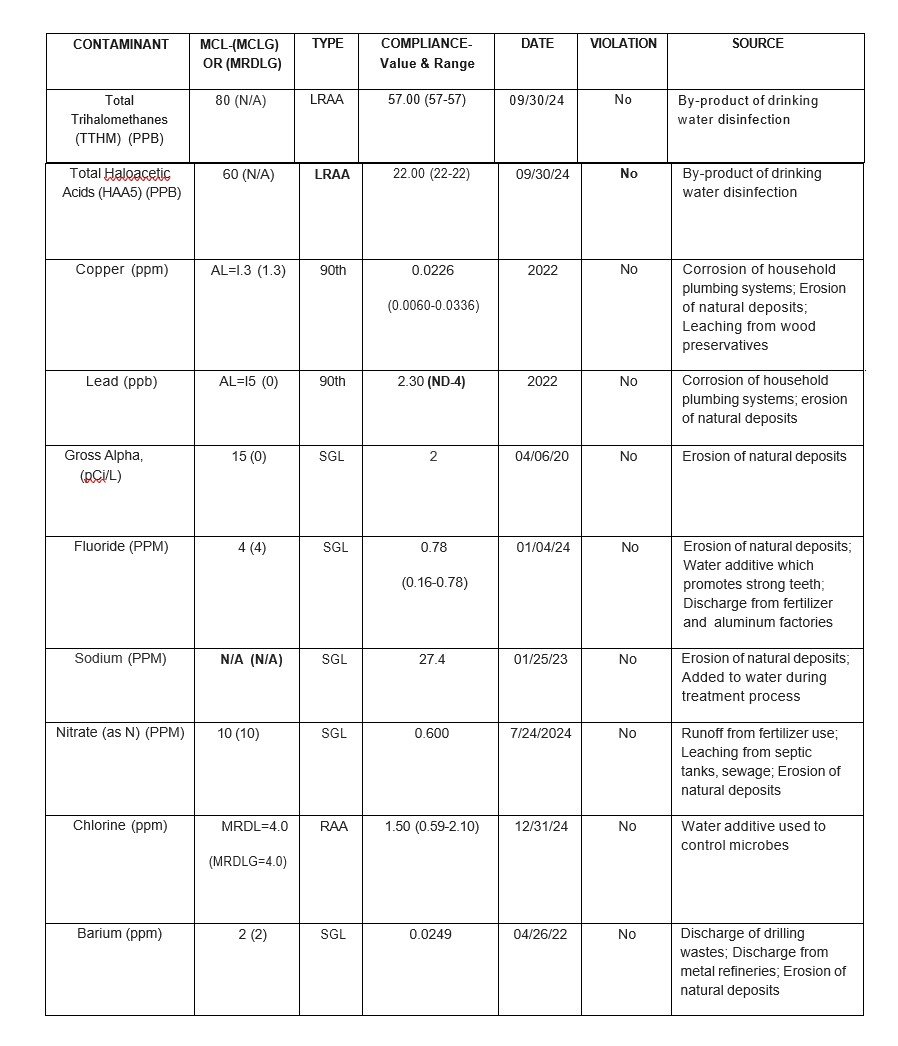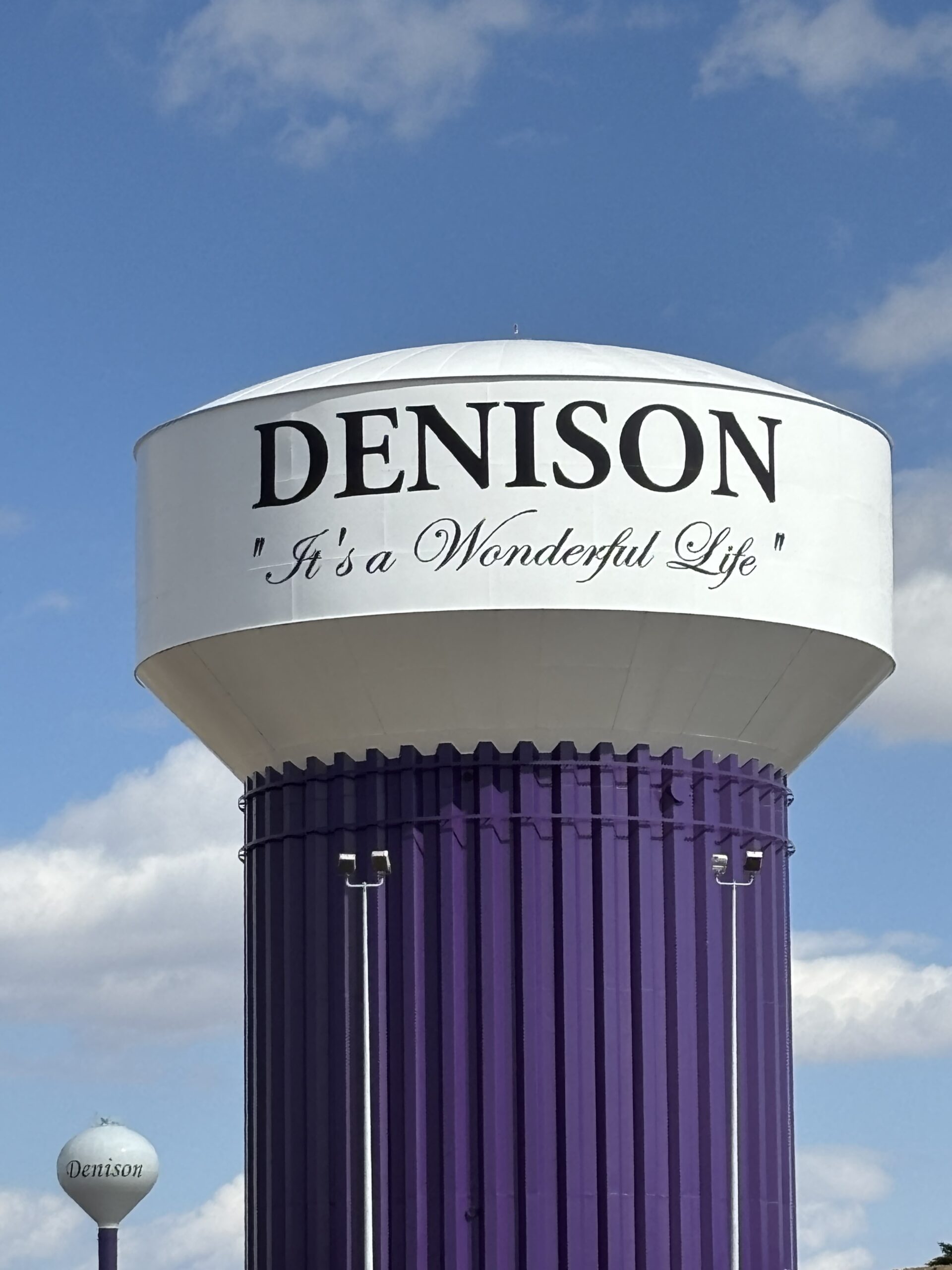
2024 DMU Water Quality Report
English
This report contains very important information about the quality of your drinking water.
Please read this report or contact someone who can translate the information.
Water Quality Data Table
In order to ensure that tap water is safe to drink, EPA prescribes regulations which limit the amounts of contaminants in water provided by public water systems. The table below lists ail of the drinking water contaminants that we detected during the calendar year of this report. Although many more contaminants were tested, only those substances listed below were found in your water. All sources of drinking water contain some naturally occurring contaminants. At low levels, these substances are generally not harmful in our drinking water. Removing all contaminants would be extremely expensive, and in most cases, would not provide increased protection of public health. A few naturally occurring minerals may actuaily improve the taste of drinking water and have nutritional value at low levels. Unless otherwise noted, the data presented in this table is from testing done in the calendar year of the report. The EPA or the State requires us to monitor for certain contaminants less than once per year because the concentrations of these contaminants do not vary significantly from year to year, or the system is not considered vulnerable to this type of contamination. As such, some of our data, though representative, may be more than one year old. In this table you will find terms and abbreviations that might not be familiar to you. To help you better understand these terms, we have provided the definitions below the table.

Definitions
MCL (Maximum Contaminant Level} The highest level of a contaminant that is allowed in drinking water. MCL's are set as close fo the MCLG's as feasible using the best available treatment technology.
MCLG (Maximum Contaminant Level Goal) The level of a contaminant in drinking water below which there is no known or expected risk fo health. MCLG’s allow for a margin of safety.
PPB (Parts Per Billion)
PPM (Parts Per Million)
pCi/L (Picocuries Per Liter)
N/A (Not Applicable)
ND (Not Detected)
RAA (Running Annual Average)
LRAA (Locational Running Annual Average)
IDSE (Initial Distribution System Evaluation)
TT (treatment Technique) A required process intended to reduce the level of a contaminant in drinking water
AL (Action Level) The concentration of a contaminant which, if exceeded, triggers treatment or other requirements which a water system must follow.
MRDLG (Maximum Residual Disinfection Level Goal} The level of a drinking water disinfectant below which there is no known or expected heolth risk. MRDLG's do not reflect the benefits of the use of disinfectants to control microbial contaminants.
MRDL (Maximum Residual Disinfection Level) The highest level of a disinfectant allowed in drinking water. There is convincing evidence fhat addition of a disinfectant is necessary for control of microbial contaminants.
SGL (Single Sample Result}
RTCR (Revised Total Coliform Rule}
ug/L (Micrograms Per Liter or Parts Per Billion) Parts of contaminant per billion parts of water. One part per billion is equivalent to a single penny in ten million dollars.
NTU (Nephelometric Turbidity Units)

General Information
Drinking water, including bottled water, may reasonably be expected to contain at least small amounts of some contaminants. The presence of contaminants does not necessarily indicate that water posed a health risk. More information about contaminants or potential health effects can be obtained by calling the Environmental Protection Agency's Safe Drinking Water Hotline ((800) 426-4791)
Some people may be more vulnerable to contaminants in drinking water than the general population. Immuno-compromised persons such as persons with cancer undergoing chemotherapy, persons who have undergone organ transplants, people with HIV/AIDs or other immune system disorders, some elderly, and infants can be particularly at risk from infections. These people should seek advice about drinking water from their health care providers. EPA/CDC guidelines on appropriate means to lessen the risk of infection by Cryptosporidium and other microbial contaminants are available from the Safe Drinking Water Hotline ((800) 426-4791).
If present, elevated levels of lead can cause serious health problems, especially for pregnant women and young children. Lead in drinking water is primarily from materials and components associated with service lines and home plumbing. Denison Municipal Utilities is responsible for providing high quality drinking water, but cannot control the variety of materials used in plumbing components. When your water has been sitting for several hours, you can minimize the potential for lead exposure by flushing your tap for thirty seconds to two minutes before using water for drinking or cooking. If you are concerned about lead in your water, you may wish to have your water tested. Information about lead in drinking water, testing methods and steps you can take to minimize exposure is available from the Safe Drinking Water Hotline or at http://www.epa.gov/safewater/lead
Source Water Assessment
The Denison Municipal Water Supply obtains its water from an alluvial formation along the Boyer River bottom. The aquifer was determined to be highly susceptible to contamination because the characteristics of the aquifer and overlying materials provide little protection from contamination at the land surface. The alluvial wells will be highly susceptible to surface contaminants such as leaking Underground storage tanks, contaminant spills, and excess fertilizer application. A detailed evaluation of your source water was completed by the lowa Department of Natural Resources and is available from the water department at (712) 263-4458.
Contact Information
For questions regarding this information or how you can get involved in decisions regarding the water system, please call the DMU Water Office at (712) 263-4458.
